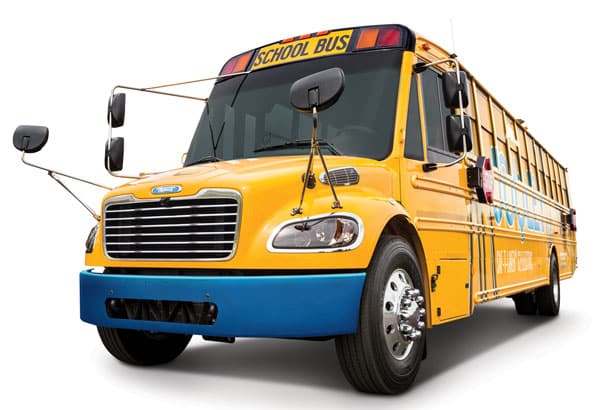According to data from the U.S. Department of Energy’s Argonne National Laboratory, electric school buses are the best at lowering the emissions that affect student health and the carbon emissions that impact the health of our kids, our communities and our planet.
We are at a pivotal moment – one that calls for providing sound evidence to transportation decision-makers trying to protect children’s health and the environment. That’s why we’re taking time here to summarize the evidence on:
- Tailpipe emissions
- Carbon emissions
- Range and reliability
Tailpipe Emissions
The evidence on tailpipe emissions is clear: electric school buses have zero direct tailpipe emissions, so students and drivers are protected from the dangerous air pollutants produced by propane and diesel fuels. These air pollutants can contribute to respiratory disease, heart disease, cancer and other mental and physical health problems.
Carbon Emissions
The evidence on total carbon emissions is also clear: even when accounting for emissions from electricity production, electric school buses generate considerably fewer greenhouse gas emissions than buses that run on propane or diesel.
Let’s look more closely at propane. Including in regions that currently rely more heavily on coal, natural gas and oil for their electricity generation, the full lifecycle emissions of greenhouse gases of electric buses are less than those of propane buses: 38% less in the Midwest and 47% less in the South Central U.S, for example. Where the use of renewables and other carbon-free energy is highest, in New England, emissions are 76% less. This includes emissions from fuel production and bus operation.
The chart below illustrates how electric school buses have lower lifecycle greenhouse gas emissions on a per-mile basis than either diesel or propane, on a national average as well as across all regions. It’s important to look at regional emissions data because electrons flow freely throughout interconnected regions, and the actual carbon intensity of a kilowatt-hour consumed is tied to the electricity pool that serves the vehicle.

Source: AFLEET Tool 2020, accessed August 16, 2022. Analysis conducted for each grid region and the U.S. average with default school bus parameters; “Wells-to-Wheels Petroleum Use, GHGs, and Air Pollutants” option selected. CO2 equivalent emissions standardize the global warming potential of different greenhouse gas emissions.
Why are electric school buses better when it comes to reducing greenhouse gas emissions? When looking at vehicle operations, we must consider how efficiently the vehicle can convert energy into miles traveled. Electric motors are significantly more efficient at converting energy from the grid to power at the wheels than internal combustion engines are — with electric vehicles converting 77 to 100% of delivered grid energy to vehicle energy.
In comparison, if you’ve ever been near a running engine or exhaust pipe of a fossil fuel vehicle, you are familiar with the waste energy that is released as heat, resulting in efficiencies of less than 45% for diesel vehicles and even lower for propane (due to the lower energy content of propane fuel).
Furthermore, the total greenhouse gas emissions associated with electric school buses will continue to improve as our electric grid gets cleaner and cleaner with the addition of more renewable energy. Already, data show that carbon emissions from power plants have declined by more than 30% over the last 20 years. Current market conditions, spurred on by technology advancements as well as recent federal incentives and the push for renewable energy at the state level, indicate this trend will continue long-term, making the electric grid cleaner and even less carbon-intensive over the next decade.
Range and Reliability
Finally, electric school buses can work for communities everywhere and are rapidly becoming more commonplace, with buses committed in 38 states, across urban, suburban and rural areas. That includes hot climates like Phoenix, Arizona and cold ones like Tok, Alaska.
And with recent data showing a nearly 10-fold increase in commitments to electric school buses in the past year, alongside the recent increase in incentives at the federal and state levels, there’s no doubt: many more electric school buses are on their way.
The Environmental Protection Agency (EPA) is supporting the transition to electric school buses in their first round of Clean School Bus Program funding with larger rebate amounts compared to other bus types and by offering funding for charging infrastructure. That support underscores the overall health and environmental benefits of electric school buses.
It’s clearly time to modernize. Let’s put fossil fuel-powered buses in the rear-view mirror – for today’s students, and for generations to come.

